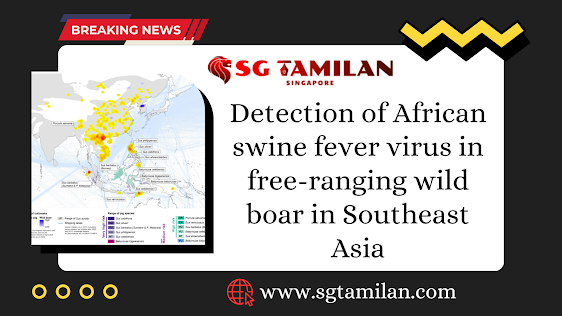Detection of African swine fever virus in free-ranging wild boar in Southeast Asia
Singapore News in Tamil Detecting the African swine fever (ASF) virus in free-ranging wild boar throughout Southeast Asia is an imperative situation for the region's agricultural and environmental health. The unfolding of this enormously contagious virus poses considerable challenges to the swine enterprise and biodiversity. Understanding the dynamics of ASF transmission in wild boar populations is critical for surveillance and manipulation measures.
ASF and Its Impact on Wild Boar
African swine fever is a viral sickness affecting home and wild pigs. While it does not have an effect on humans, it can decimate complete swine populations, inflicting excessive mortality prices amongst contaminated animals. The virus spreads through direct contact with contaminated pigs or through contaminated substances like clothing, vehicles, or feed. Southeast Asia has skilled numerous outbreaks, resulting in tremendous monetary losses and ecological disturbances due to wild boar infections.
Challenges in Detection
Detecting ASF in free-ranging wild boar offers special challenges. These animals roam large territories, making usual surveillance techniques much less effective. Moreover, contaminated wild boars can act as silent carriers, spreading the virus besides displaying obvious symptoms, and complicating early detection efforts.
Diagnostic Techniques
Several diagnostic strategies are useful resources in figuring out ASF in wild boar populations. PCR (Polymerase Chain Reaction) exams assist in observing viral DNA in samples like blood, tissue, or swabs. Singapore News in Tamil Serological assessments discover antibodies produced with the aid of contaminated animals as an immune response to the virus. Combining these techniques improves the accuracy of ASF detection.
Surveillance Strategies
Implementing sturdy surveillance techniques is vital for early detection and containment of ASF in wild boar. This entails an aggregate of lively and passive surveillance methods. Active surveillance consists of focused sampling in high-risk areas, whilst passive surveillance includes reporting and trying out unwell or lifeless wild boar observed in the region.
Regional Collaborations
Efforts to fight ASF in Southeast Asia require collaborative initiatives among countries. Sharing data, resources, and first-class practices fosters a cohesive method of disorder management. Regional alliances can streamline surveillance efforts, harmonize diagnostic protocols, and facilitate an extra wonderful response to outbreaks.
Risk Mitigation Measures
Implementing stringent biosecurity measures is paramount in stopping ASF spread. Strict controls on pig movements, desirable disposal of contaminated carcasses, and disinfection protocols decrease the threat of virus transmission. Public recognition campaigns additionally play a crucial position in instructing communities about ASF prevention and control.
Challenges and Future Directions
Despite ongoing efforts, challenges persist in controlling ASF in wild boar populations. Limited resources, numerous geographical landscapes, and the complicated nature of wild ecosystems pose good-sized hurdles. Continued look into vaccines, elevated diagnostic tools, and appreciation of the virus's conduct in numerous environments is vital for higher sickness management.
Conclusion
Singapore News in Tamil The detection of African swine fever in free-ranging wild boar remains an urgent difficulty in Southeast Asia. Strengthening surveillance, bettering diagnostic capabilities, and fostering regional collaborations are pivotal in combating the unfolding of this devastating virus. Mitigating ASFs' impact on on wild boar populations is fundamental now not solely for the swine enterprise but additionally for maintaining biodiversity and safeguarding the ecological stability in the region.




Comments
Post a Comment